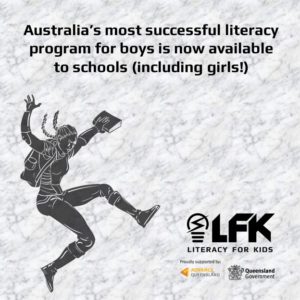Data Proven Literacy Program for Schools and Parents

What does it take to create and maintain a successful school literacy program? How do you engage the low achievers? Extend those with higher abilities? Help students to make it clear what they need to improve? How can I make Grammar and Punctuation ‘fun‘? Can the program be useful during remote learning?
As a teacher and tutor, I was passionate about raising literacy and comprehension results, especially for our Aussie kids. Teaching children how to read and write are two of the hardest feats a teacher will be asked to complete. Having an effective literacy program helps teachers complete that difficult task effectively. So what components make a great literacy program?
1) Understanding Learners’ Needs
Learning is more enjoyable and rewarding when it is an active process. Our belief is that unless kids are engaged with the material they will not learn. Our LFK model relies on and revolves around the successful integration of 3 core elements:
a) Content which is targeted and relevant to the audience and will generate interest.
b) A delivery mode that that appeals to the user.
c) An education platform that can provide the learning outcomes.
Literacy For Kids operates on an engagement model which we call ‘LFK’.
Learner specific – Fun content – Key skill focussed
2) Understanding a School’s Needs
I spent a lot of time sifting through teaching/learning research, online programs, techniques and tools. I did not find a program that catered for students from Year 3 through to high school, that focussed on each of the core literacy areas. I set out to design a program that could be used by all teachers in a school and could: 
- provide instruction that targets the individual learning needs and potential of students
- cover all literacy concepts – comprehension, grammar, spelling, punctuation
- provide students, teachers, and parents with accurate, validated and centralised data that could be owned by students and used by teachers to plan teaching concepts
- capture the students’ interest as they examine text, spelling and grammar and acquire skills in manipulating them.
3) Tracking, sharing and communicating data
An engaging literacy program with ‘cool’ topics was not enough by itself – it had to be supported by a data tracking system.
For students and parents, this meant it had to show what they were learning and why and how they were improving. As John Hattie (Professor and researcher in education) describes it: what am I doing; why am I doing it; and when will I know if I’m successful?
Reciprocally, a program should hold students accountable for their decline or lack of engagement.
For teachers, it meant that the data needed to be collated, centralised, and communicated easily, so that they could understand each student’s strengths and areas for literacy improvement. Analytics track each student’s literacy assessment data and summarises a student’s literacy competencies.
4) Evidence and results
The evidence speaks for itself. Independent trials in schools (using standardised testing prior and post using the program), showed that students (boys and girls) made an average improvement of 18 months in their reading, comprehension and spelling results after only 18 weeks on the program. Click here for data results. An average jump of 18 months after only two terms!
“At the conclusion of the 18-week trial we used those same tests to measure the distance travelled and were delighted to see an increase of nearly 12 months across all those areas. Most important was the anecdotal feedback from our students who were engaged and enjoying using the program. The program allows for differentiated delivery of content in an enticing platform that has captured not only the interest of our students.” Ed Gordon – Deputy Principal, Eatons Hill State School
100% of our schools renewed their subscriptions for the 2021 year. The transition to distance literacy learning during the pandemic has been straightforward for our existing schools ~ students navigated the literacy topics with ease and teachers could track student progress and achievement.
5) For Parents
Getting kids interested in doing their literacy homework is tough! It becomes an almost impossible task when your child cannot relate to or is not interested in literacy activities. So with this in mind, Literacy for Kids developed material that children will love. We just received this from a parent last week:
Hi Tanya,
Just want to say- that is such great news you have been able to expand the program for girls as well. My boys are loving the program. We are in Sydney so have been using Literacy for Boys to supplement the work coming home from school during remote learning. As a working mum I don’t have time to help my son write a newspaper article about an Olympics event as requested by school so it was great my son could do a Literacy for Boys topic as a substitute. Claire, mum
Contact us
Looking for a new literacy program for your class or school? Students from Years 3 to 9 wanting extra practice with their comprehension, spelling, grammar and punctuation can enrol in our program Literacy for Kids
Want a literacy program that you can use at home? Here is feedback from one of our parents:
“Your website is wonderful. I am so glad that I discovered it. Our two boys love the topics.” (Amelia)
Feel free to contact us info@literacyforkids.com.au to enrol for a FREE 2-week trial.
Check out our blogs for more ideas and tips.
Steps to Successfully Support Disengaged Learners
See us featured in The Educator Australia magazine
Research confirms that early reading boosts literacy
Boys Love LFB – Here’s what they have to say!
Get boys reading in the digital age
Why write? Tips for reluctant writers
Brought to you by Tanya Grambower

